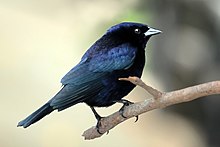| Shiny cowbird | |
|---|---|

| |
| Adult male | |
| Shiny cowbird call and song | |
| Scientific classification | |
| Domain: | Eukaryota |
| Kingdom: | Animalia |
| Phylum: | Chordata |
| Class: | Aves |
| Order: | Passeriformes |
| Family: | Icteridae |
| Genus: | Molothrus |
| Species: | M. bonariensis
|
| Binomial name | |
| Molothrus bonariensis (Gmelin, JF, 1789)
| |

| |
Resident
| |
The shiny cowbird (Molothrus bonariensis) is a passerine bird in the New World family Icteridae. It breeds in most of South America except for dense forests and areas of high altitude such as mountains.[2] Since 1900 the shiny cowbird's range has shifted northward, and it was recorded in the Caribbean islands as well as the United States, where it is found breeding in southern Florida.[3] It is a bird associated with open habitats, including disturbed land from agriculture and deforestation.[2]
Adults are sexually dimorphic. Males are all black with a purple-blue iridescence. The female is smaller, with dull brown plumage that is sometimes paler on the underparts. Females of the species can be distinguished from the female brown-headed cowbird by their longer, finer bills and flatter heads.[2] The shiny cowbird's diet consists mainly of insects, other arthropods[4] and seeds, and they have been recorded foraging for grains in cattle troughs.[2]
Like most other cowbirds, it is an obligate brood parasite, laying its eggs in the nests of many other bird species such as the rufous-collared sparrow.[5] Different host species show different responses to their nests being parasitised, with behaviours ranging from accepting and caring for the cowbird eggs, to rejecting the eggs from the nest.[2] As the shiny cowbird is an effective generalist brood parasite, it can be considered the South American counterpart to the brown-headed cowbird.[6]
- ^ BirdLife International (2018). "Molothrus bonariensis". IUCN Red List of Threatened Species. 2018: e.T22724345A131890003. doi:10.2305/IUCN.UK.2018-2.RLTS.T22724345A131890003.en. Retrieved 27 November 2022.
- ^ a b c d e Lowther, Peter E. (2011-01-21). Schulenberg, Thomas S. (ed.). "Shiny cowbird (Molothrus bonariensis)". Neotropical Birds. doi:10.2173/nb.shicow.01.
- ^ Lowther, Peter; Post, William (1999). "Shiny cowbird (Molothrus bonariensis)". The Birds of North America Online. doi:10.2173/bna.399. ISSN 1061-5466.
- ^ "Molothrus bonariensis (Shiny Cowbird)" (PDF). The Online Guide to the Animals of Trinidad and Tobago. UWI.
- ^ Friedmann, Herbert; Kiff, Lloyd F.; Rothstein, Stephen I. (1977). "A further contribution of knowledge of the host relations of the parasitic cowbirds". Smithsonian Contributions to Zoology (235): 1–75. doi:10.5479/si.00810282.235. ISSN 0081-0282. S2CID 144095171.
- ^ Lowther, Peter; Post, William (1999). Poole, A.; Gill, F. (eds.). "Shiny cowbird (Molothrus bonariensis)". The Birds of North America Online. doi:10.2173/bna.399. ISSN 1061-5466.
